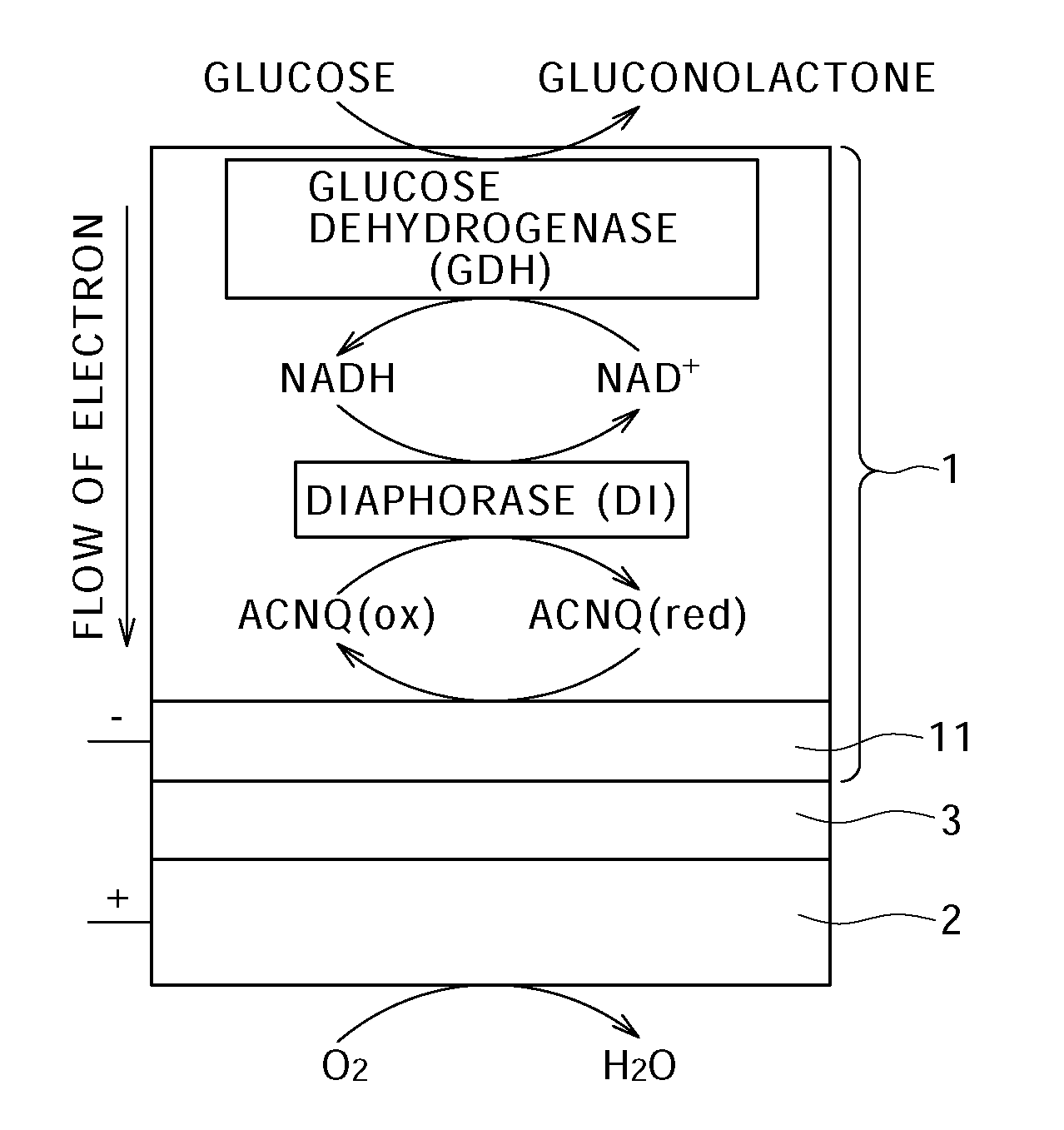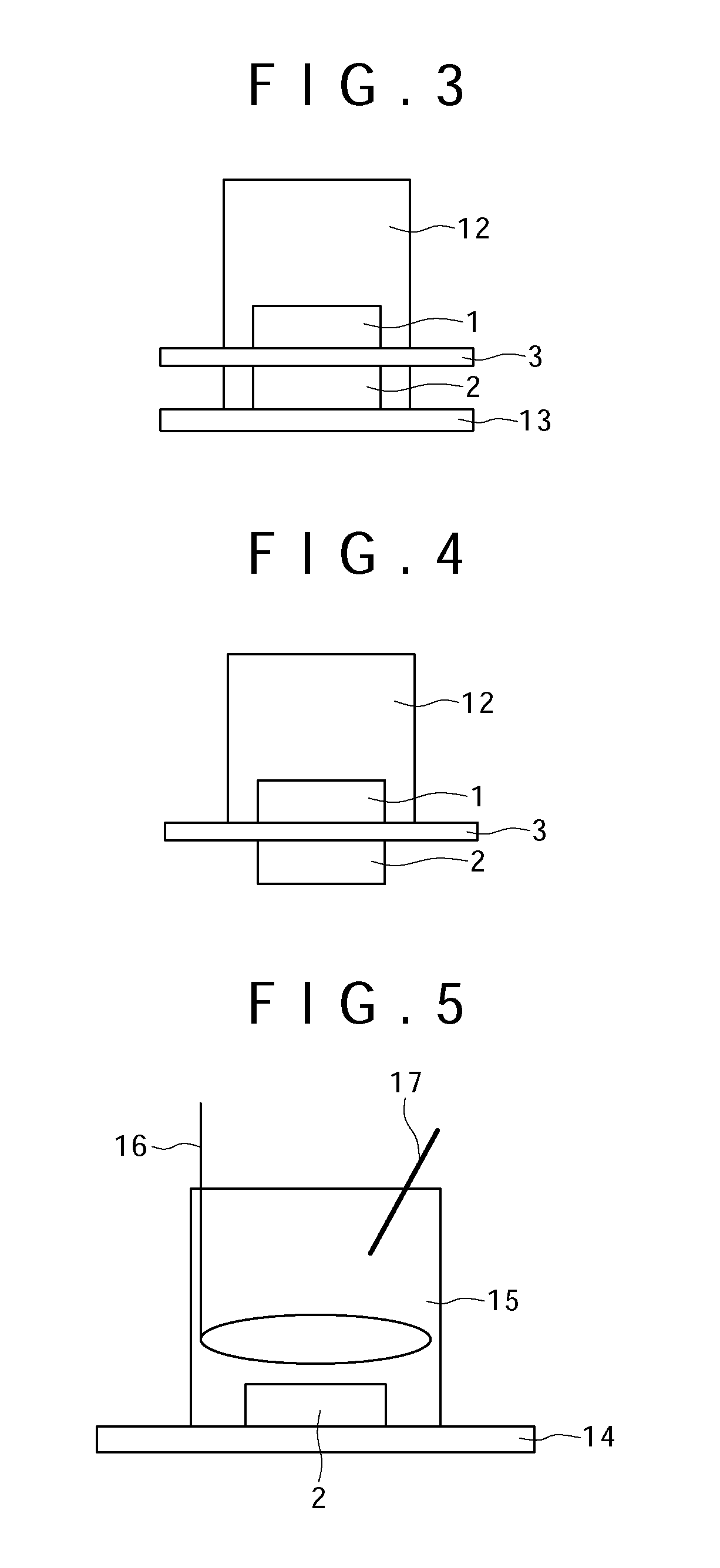Fuel cell, manufacturing method thereof, electronic apparatus, enzyme-immobilized electrode, manufacturing method thereof, water-repellent agent, and enzyme immobilizing material
- Summary
- Abstract
- Description
- Claims
- Application Information
AI Technical Summary
Benefits of technology
Problems solved by technology
Method used
Image
Examples
first embodiment
[0108]FIG. 1 schematically shows a biofuel cell according to this invention. Suppose that glucose is used as the fuel in this biofuel cell. FIG. 2 schematically shows the details of the configuration of the anode of this biofuel cell, one example of the group of enzymes immobilized to this anode, and reaction of electron receiving / passing by this enzyme group.
[0109]As shown in FIG. 1, this biofuel cell has a structure in which an anode 1 and a cathode 2 are opposed with the intermediary of an electrolyte layer 3 that conducts only the proton. The anode 1 breaks down the glucose supplied as the fuel by the enzymes to draw electrons and generate protons (H+). The cathode 2 produces water by the proton transported from the anode 1 via the electrolyte layer 3, the electron sent from the anode 1 via an external circuit, and e.g. oxygen in the air.
[0110]The anode 1 is configured by immobilizing, on an electrode 11 (see FIG. 2) composed of e.g. porous carbon or the like, an enzyme involved...
second embodiment
[0146]Next, a biofuel cell according to this invention will be described below.
[0147]In this biofuel cell, the electrolyte layer 3 has a charge of the same sign as that of the charge of the oxidized form or reduced form of the electron mediator used for the cathode 2 and the anode 1. For example, at least the surface of the electrolyte layer 3 on the side of the cathode 2 is negatively charged and has a negative charge. Specifically, for example, a polyanion having a negative charge is included in the whole or part of at least the part of this electrolyte layer 3 on the side of the cathode 2. Preferably, as this polyanion, Nafion (commercial product name, by U.S. DuPont), which is an ion-exchange resin having a fluorine-containing carbon sulfonic acid group, is used.
[0148]Here, a description will be made below about the results of comparative experiments made in order to verify that, if the electrolyte layer 3 has a charge of the same sign as that of the charge of the oxidized form ...
third embodiment
[0152]Next, a biofuel cell according to this invention will be described below.
[0153]FIG. 27(A), FIG. 27(B), FIG. 27(C), and FIG. 28 show this biofuel cell. FIG. 27(A), FIG. 27(B), and FIG. 27(C) are a top view, a sectional view, and a back view of this biofuel cell, and FIG. 28 is an exploded perspective view showing the respective constituent elements of this biofuel cell in an exploded manner.
[0154]As shown in FIG. 27(A), FIG. 27(B), FIG. 27(C), and FIG. 28, in this biofuel cell, inside the space formed between a cathode current collector 51 and an anode current collector 52, a cathode 2, an electrolyte layer 3, and an anode 1 are so housed that the tops and bottoms thereof are sandwiched by the cathode current collector 51 and the anode current collector 52. Components adjacent to each other among these cathode current collector 51, anode current collector 52, cathode 2, electrolyte layer 3, and anode 1 are in tight contact with each other. In this case, these cathode current co...
PUM
 Login to View More
Login to View More Abstract
Description
Claims
Application Information
 Login to View More
Login to View More - R&D
- Intellectual Property
- Life Sciences
- Materials
- Tech Scout
- Unparalleled Data Quality
- Higher Quality Content
- 60% Fewer Hallucinations
Browse by: Latest US Patents, China's latest patents, Technical Efficacy Thesaurus, Application Domain, Technology Topic, Popular Technical Reports.
© 2025 PatSnap. All rights reserved.Legal|Privacy policy|Modern Slavery Act Transparency Statement|Sitemap|About US| Contact US: help@patsnap.com



